小学一般现在时(详细讲解)讲解学习
- 格式:ppt
- 大小:289.00 KB
- 文档页数:30
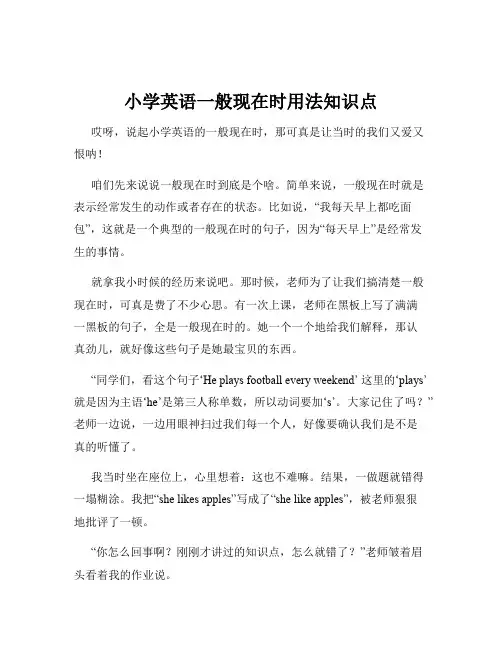
小学英语一般现在时用法知识点哎呀,说起小学英语的一般现在时,那可真是让当时的我们又爱又恨呐!咱们先来说说一般现在时到底是个啥。
简单来说,一般现在时就是表示经常发生的动作或者存在的状态。
比如说,“我每天早上都吃面包”,这就是一个典型的一般现在时的句子,因为“每天早上”是经常发生的事情。
就拿我小时候的经历来说吧。
那时候,老师为了让我们搞清楚一般现在时,可真是费了不少心思。
有一次上课,老师在黑板上写了满满一黑板的句子,全是一般现在时的。
她一个一个地给我们解释,那认真劲儿,就好像这些句子是她最宝贝的东西。
“同学们,看这个句子‘He plays football every weekend’ 这里的‘plays’就是因为主语‘he’是第三人称单数,所以动词要加‘s’。
大家记住了吗?”老师一边说,一边用眼神扫过我们每一个人,好像要确认我们是不是真的听懂了。
我当时坐在座位上,心里想着:这也不难嘛。
结果,一做题就错得一塌糊涂。
我把“she likes apples”写成了“she like apples”,被老师狠狠地批评了一顿。
“你怎么回事啊?刚刚才讲过的知识点,怎么就错了?”老师皱着眉头看着我的作业说。
我低着头,红着脸,心里别提多难受了。
从那以后,我发誓一定要把一般现在时给学好。
每天放学回家,我都会拿出英语课本,把那些一般现在时的句子读了一遍又一遍。
我还会自己造句子,比如说“My mother cooks delicious food every day” 然后再对照着课本检查自己有没有写错。
还有一次,老师组织了一场小组比赛,看哪个小组能最快最准确地用一般现在时造句。
我们小组的小伙伴们都紧张得不行,大家你一言我一语地讨论着。
“我想到一个,‘We go to school by bike’” 一个同学说。
“不行不行,这个太简单了,老师肯定不满意。
”另一个同学反驳道。
最后,经过我们的努力,终于造出了几个让老师都称赞的句子,我们小组还得了第一名呢!再比如说,当我们描述一些客观事实的时候,也会用到一般现在时。
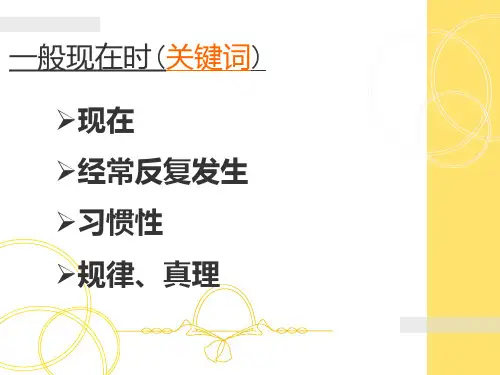
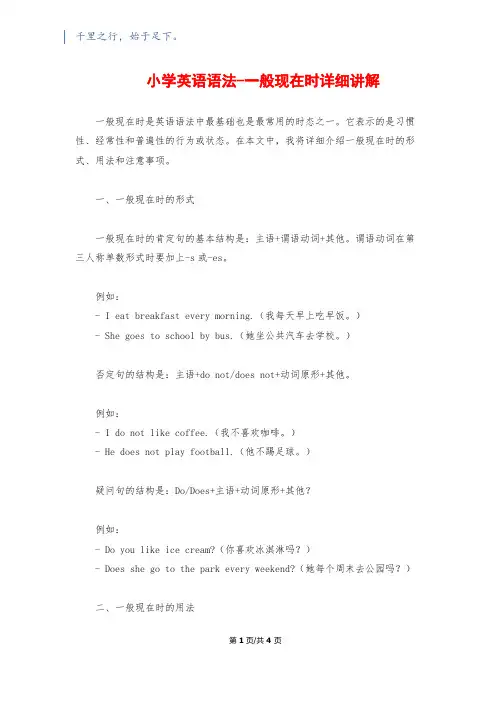
小学英语语法-一般现在时详细讲解一般现在时是英语语法中最基础也是最常用的时态之一。
它表示的是习惯性、经常性和普遍性的行为或状态。
在本文中,我将详细介绍一般现在时的形式、用法和注意事项。
一、一般现在时的形式一般现在时的肯定句的基本结构是:主语+谓语动词+其他。
谓语动词在第三人称单数形式时要加上-s或-es。
例如:- I eat breakfast every morning.(我每天早上吃早饭。
)- She goes to school by bus.(她坐公共汽车去学校。
)否定句的结构是:主语+do not/does not+动词原形+其他。
例如:- I do not like coffee.(我不喜欢咖啡。
)- He does not play football.(他不踢足球。
)疑问句的结构是:Do/Does+主语+动词原形+其他?例如:- Do you like ice cream?(你喜欢冰淇淋吗?)- Does she go to the park every weekend?(她每个周末去公园吗?)二、一般现在时的用法第1页/共4页1. 表示习惯或经常性的动作:- I write in my diary every night.(我每天晚上写日记。
)- They play basketball every Sunday.(他们每个星期天打篮球。
)2. 表示客观事实、自然规律或科学真理:- Water boils at 100 degrees Celsius.(水在100摄氏度时煮沸。
)- The sun rises in the east.(太阳从东方升起。
)3. 表示感觉、想法和喜好:- I love chocolate.(我喜欢巧克力。
)- He hates to wake up early.(他讨厌早起。
)4. 表示现时状态或现时临时的动作:- I am a student.(我是一个学生。
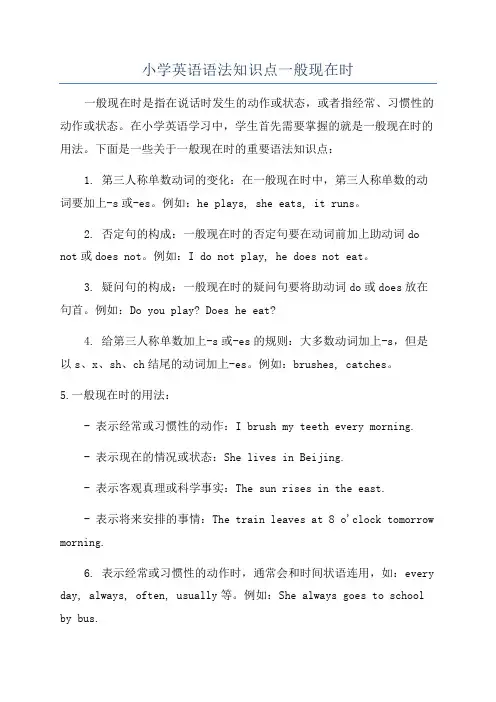
小学英语语法知识点一般现在时一般现在时是指在说话时发生的动作或状态,或者指经常、习惯性的动作或状态。
在小学英语学习中,学生首先需要掌握的就是一般现在时的用法。
下面是一些关于一般现在时的重要语法知识点:1. 第三人称单数动词的变化:在一般现在时中,第三人称单数的动词要加上-s或-es。
例如:he plays, she eats, it runs。
2. 否定句的构成:一般现在时的否定句要在动词前加上助动词do not或does not。
例如:I do not play, he does not eat。
3. 疑问句的构成:一般现在时的疑问句要将助动词do或does放在句首。
例如:Do you play? Does he eat?4. 给第三人称单数加上-s或-es的规则:大多数动词加上-s,但是以s、x、sh、ch结尾的动词加上-es。
例如:brushes, catches。
5.一般现在时的用法:- 表示经常或习惯性的动作:I brush my teeth every morning.- 表示现在的情况或状态:She lives in Beijing.- 表示客观真理或科学事实:The sun rises in the east.- 表示将来安排的事情:The train leaves at 8 o'clock tomorrow morning.6. 表示经常或习惯性的动作时,通常会和时间状语连用,如:every day, always, often, usually等。
例如:She always goes to school by bus.7. 表示现在的情况或状态时,通常与be动词连用,如:am, is, are。
例如:I am a student.8. 表示客观真理或科学事实时,通常不和时间状语连用。
例如:Water boils at 100 degrees Celsius.9.一般现在时中的一些特殊用法:- 示意要求或建议的动词(如:want, need, like, love, hate等)后接不定式,用法类似于祈使句。

小学英语语法时态一般现在时一般现在时(Simple Present Tense)是英语语法中最基本的一种时态,表示目前正发生的动作、存在的状态或经常性的动作。
以下是关于一般现在时的相关用法和规则。
一、动词的变化:一般现在时中,动词的第三人称单数形式(he、she、it等)需加上-s或-es。
例如:- I play football.(我踢足球。
)- She cooks dinner.(她做晚饭。
)- He watches TV.(他看电视。
)但是,以下情况除外:1. 当动词以某些字母结尾时,在动词后面直接加上-s,而不再加-es。
这些字母包括:-o(goes)、-ss(passes)、-x(fixes)、-ch(watches)、-sh(rushes)等。
例如:- She goes to school.(她去上学。
)- He passes the exam.(他通过了考试。
)2. 当动词以辅音字母+y结尾时,要将y改为i,再加-es。
例如:- He studies English.(他学习英语。
)- She tries her best.(她尽力。
)第1页/共4页3. 当动词以-e结尾时,只需加上-s。
例如:- They write letters.(他们写信。
)- He can dance.(他会跳舞。
)二、用法:1. 描述客观事实或经常性动作:一般现在时常用于描述客观事实或经常性动作。
例如:- Water boils at 100 degrees Celsius.(水沸腾的温度是100摄氏度。
)- I usually go to bed at 10 o'clock.(我通常在10点钟上床睡觉。
)2. 描述现阶段的状态:一般现在时还可用来描述现阶段的状态或对现实情况的评论。
例如:- They live in New York.(他们住在纽约。
)- She looks tired.(她看起来很累。

小学英语之时态——一般现在时一般现在时基本用法介绍【No。
1】一般现在时的功能1。
表示事物或人物的特征、状态。
如:The sky is blue。
天空是蓝色的。
2。
表示经常性或习惯性的动作。
如:I get up at six every day。
我天天六点起床。
3。
表示客观现实。
如:The earth goes around the sun。
地球绕着太阳转。
一般现在时的构成1。
be动词:主语be(am,is,are)其它。
如:I am a boy。
我是一个男孩。
2。
行为动词:主语行为动词(其它)。
如:We study English。
我们学习英语。
当主语为第三人称单数(he,she,it)时,要在动词后加“-s”或“-es”。
如:Mary likes Chinese。
玛丽喜欢汉语。
【No。
2】一般现在时的变化1。
be动词的变化。
否定句:主语be not 其它。
如:He is not a worker。
他不是工人。
一般疑问句:Be 主语其它。
如:-Are you a student?-Yes。
I am。
/ No,I‘m not。
非凡疑问句:疑问词一般疑问句。
如:Where is my bike?2。
行为动词的变化。
否定句:主语don’t(doesn‘t )动词原形(其它)。
如:I don’t like bread。
当主语为第三人称单数时,要用doesn‘t构成否定句。
如:He doesn’t often play。
一般疑问句:Do(Does )主语动词原形其它。
如:- Do you often play football?- Yes,I do。
/ No,I don‘t。
当主语为第三人称单数时,要用does构成一般疑问句。
如:- Does she go to work by bike?- Yes,she does。
/ No,she doesn’t。
动词s的变化规则1.一般情况下,直接加-s,如:cook-cooks,milk-milks2.以s。

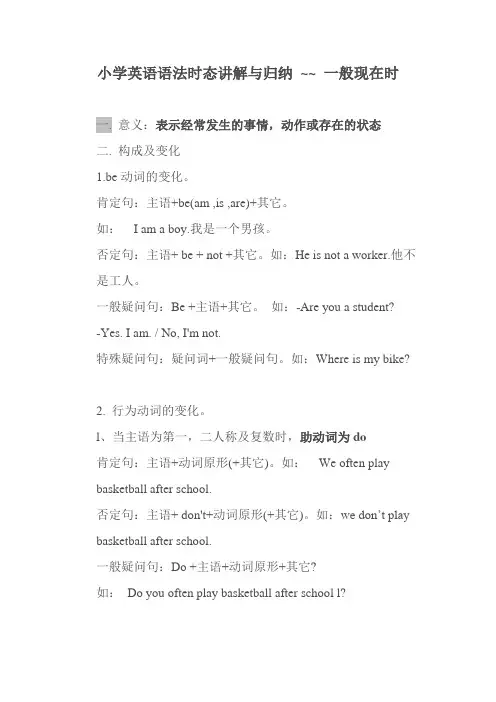
小学英语语法时态讲解与归纳~~ 一般现在时一. 意义:表示经常发生的事情,动作或存在的状态二. 构成及变化1.be动词的变化。
肯定句:主语+be(am ,is ,are)+其它。
如:I am a boy.我是一个男孩。
否定句:主语+ be + not +其它。
如:He is not a worker.他不是工人。
一般疑问句:Be +主语+其它。
如:-Are you a student?-Yes. I am. / No, I'm not.特殊疑问句:疑问词+一般疑问句。
如:Where is my bike?2. 行为动词的变化。
l、当主语为第一,二人称及复数时,助动词为do肯定句:主语+动词原形(+其它)。
如:We often play basketball after school.否定句:主语+ don't+动词原形(+其它)。
如:we don’t play basketball after school.一般疑问句:Do +主语+动词原形+其它?如:Do you often play basketball after school l?Yes, we do. / No, we don't.特殊疑问句:疑问词+以do开头的一般疑问句?如:What do you often do after school ?2、当主语为第三人称单数时,助动词为does肯定句:主语+动词三单式(+其它)。
如:He swims well.否定句:主语+ doesn’t+动词原形(+其它)。
如:He doesn’t swim well..一般疑问句:Does +主语+动词原形+其它。
如:Does he swim well ?Yes, he does. / No, he doesn't.特殊疑问句:疑问词+以does开头的一般疑问句?如:How does your father go to work?三.第三人称单数的动词变化规则(只有在第三人称为主语的肯定句中,动词才用三单式)(1)多数动词直接加s:runs gets likes collets takes plays climbs…….(2)结尾是s, x, sh, ch, o,前为辅音字母,结尾加es :watches goes does washes brushes(3)动词末尾y前为辅音:将y改为i加es:study→studies fly→flies carry→carries cry→cries但在y前如果为元音则直接加s:buys says四.时间标志:always总是, usually经常, often经常, sometimes 有时,every…每~一般现在时练习题(1)I.用下列单词的适当形式填空1.We often___________(play) in the playground.2.He _________(get) up at six o’clock.3.__________you _________(brush) your teeth everymorning?4.What________________(do) heusually________________(do) after school?5.Danny ________________(study) English, Chinese,maths, science and Art at school.6.Mike sometimes __________(go) to the park with hissister.7.At eight at night, she __________(watch) TV with hisparents.8.________ Mike________(read) English every day?Ⅱ单项选择。
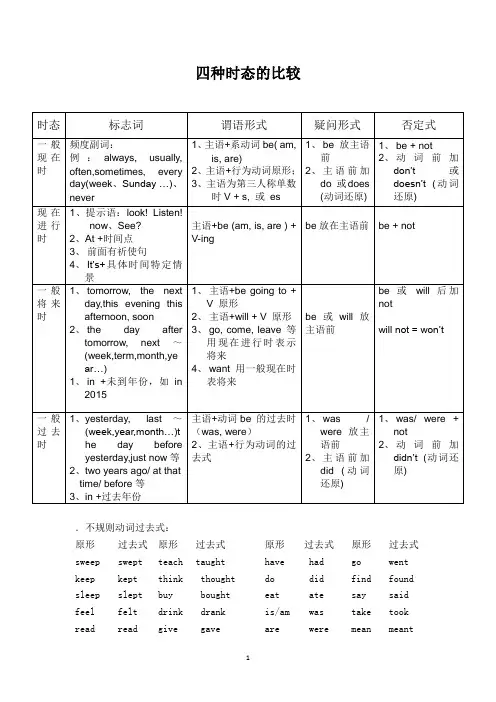
四种时态的比较.不规则动词过去式:原形过去式原形过去式原形过去式原形过去式sweep swept teach taught have had go went keep kept think thought do did find found sleep slept buy bought eat ate say said feel felt drink drank is/am was take took read read give gave are were mean meantput put sing sang drive drove meet met cut cut begin began speak spoke make made let let ring rang write wrote see saw fly flew run ran ride rode come came draw drew sit sat hear heard tell toldgrow grew learn learned/learntget got know knew一、用动词的适当形式填空1. My parents _______ (come) from Shandong.2. Sam _______(not like) playing computer games.3. The beautiful girl _______(wear) glasses.4. The Zhang family _______(live) in a flat in Nanjing.5. My father likes _______(read) newspapers after work.6. What _______her classmates _______(call) her teacher?7. _______ you _______(love) each other in your family?8. _______(be) your cousin very clever at maths?9. She is good at dancing. She ________ (sing) very well, too.11. Amy ________(take) her dog for a walk every afternoon.12. Mr. Li ________(not teach) us maths this term. (学期)13. Mr. Chen ________(not like) tea. He ________(enjoy) drinking coffee.14. ________ your father often ________(play) tennis ?No, he loves ________(read) newspapers.15. Everyone in our class ________(like) P.E. a lot.16. Who else ________(want) to come to Millie’s party? I ________.17. Many of them ________(work) hard at their lessons. They _____ (be) cl ever at them.18. What _______ Mary _______(have) for breakfast ?She _______(have) an egg and a glass of milk.19. Our school ________(be) a big nice school. And our teacher ______(be ) a good teacher.20. Simon and Daniel ________(be) American.二、句型转换。
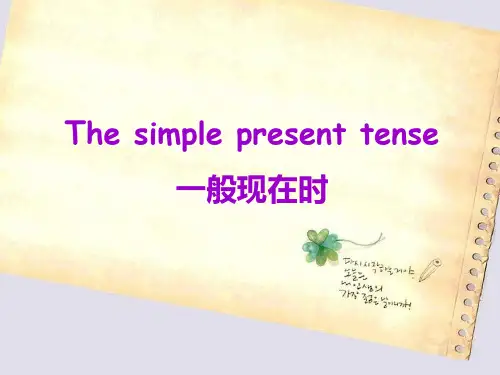
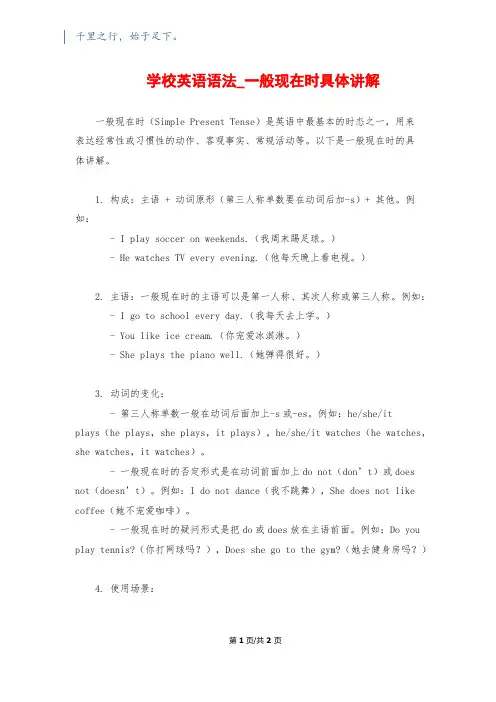
千里之行,始于足下。
学校英语语法_一般现在时具体讲解一般现在时(Simple Present Tense)是英语中最基本的时态之一,用来表达经常性或习惯性的动作、客观事实、常规活动等。
以下是一般现在时的具体讲解。
1. 构成:主语 + 动词原形(第三人称单数要在动词后加-s)+ 其他。
例如:- I play soccer on weekends.(我周末踢足球。
)- He watches TV every evening.(他每天晚上看电视。
)2. 主语:一般现在时的主语可以是第一人称、其次人称或第三人称。
例如:- I go to school every day.(我每天去上学。
)- You like ice cream.(你宠爱冰淇淋。
)- She plays the piano well.(她弹得很好。
)3. 动词的变化:- 第三人称单数一般在动词后面加上-s或-es。
例如:he/she/itplays(he plays,she plays,it plays),he/she/it watches(he watches,she watches,it watches)。
- 一般现在时的否定形式是在动词前面加上do not(don’t)或does not(doesn’t)。
例如:I do not dance(我不跳舞),She does not like coffee(她不宠爱咖啡)。
- 一般现在时的疑问形式是把do或does放在主语前面。
例如:Do you play tennis?(你打网球吗?),Does she go to the gym?(她去健身房吗?)4. 使用场景:第1页/共2页锲而不舍,金石可镂。
- 表达经常性或习惯性的动作。
例如:I eat breakfast every morning.(我每天早上吃早餐。
)- 表达客观事实、普遍真理等。
例如:The sun rises in the east.(太阳从东方升起。
小学一般现在时讲解一、什么是一般现在时?一般现在时是用来表示现在发生的动作、惯、事实,以及经常、通常发生的动作或状态。
二、一般现在时的结构和用法一般现在时的结构为主语+谓语动词(原形)+其他成分。
常用的谓语动词有:work, go, play等。
以下是一般现在时的几种常见用法:1. 表示客观真理或普遍事实- The sun rises in the east.(太阳从东方升起。
)- Water boils at 100 degrees Celsius.(水在100摄氏度沸腾。
)2. 表示经常性的动作或惯- I usually go to bed at 10 p.m.(我通常在晚上10点睡觉。
)- He often plays soccer with his friends.(他经常和朋友们踢足球。
)3. 表示现阶段的情况或状态- She lives in New York.(她住在纽约。
)- We have two cats.(我们有两只猫。
)4. 表示固定的时间表、日程安排或时间表的安排- Class starts at 9 a.m.(课程在早上9点开始。
)- The train arrives at 8:45.(火车在8点45分到达。
)三、一般现在时的注意事项1. 第三人称单数的主语在一般现在时中的动词形式要加上-s或-es。
- She works in a hospital.(她在医院工作。
)- He brushes his teeth every morning.(他每天早上刷牙。
)2. 在否定句和疑问句中需要使用助动词do/does,并将动词改为原形。
- They don't like vegetables.(他们不喜欢蔬菜。
)- Does he play the piano?(他会弹钢琴吗?)四、小练请根据下列句子中的动词填写所缺的动词形式(原形/第三人称单数形式):1. I ___________ (study) English every day.2. Tom ___________ (go) to school by bike.3. Lucy ___________ (watch) TV in the evening.4. They ___________ (play) soccer on weekends.5. The cat ___________ (sleep) in the sun.答案:1. study2. goes3. watches4. play5. sleeps以上就是关于小学一般现在时的讲解。
小学品德一般现在时讲解什么是一般现在时?一般现在时是描述现阶段正在发生的动作、存在的状态或经常性惯的一种时态。
在小学教育中,学生需要理解一般现在时的概念并能正确运用。
一般现在时的用法1. 表示经常性的动作或惯例如:我每天早上起床后刷牙。
对应的动词一般会用第三人称单数形式(he、she、it)。
2. 描述客观事实或普遍真理例如:地球绕着太阳运转。
这类句子一般不受人称或复数形式的影响。
3. 表示现阶段正在进行的动作例如:我正在写字。
此时动词用一般形式。
4. 给出日程安排或表达将来事件例如:明天我要去图书馆复。
这类情况下,一般现在时用于表示未来的计划或安排。
一般现在时的变化规则- 第三人称单数形式的动词在词尾加上's'或'es'。
例如:he plays, she watches。
- 动词以'o'、's'、'x'、'ch'、'sh'结尾时,在词尾加上'es'。
例如:goes, passes, fixes。
- 动词以辅音字母+y结尾时,将'y'改为'i',再加上'es'。
例如:studies, flies。
一般现在时的练为了加深对一般现在时的理解,以下是一些练题供同学们参考。
1. 你每天早上几点起床?2. 她们通常在周末打扫房间。
3. 地球绕着太阳运转。
4. 明天我要和朋友一起去看电影。
5. 他每天都锻炼身体。
以上是对小学品德一般现在时的简要讲解,希望能够帮助同学们掌握这个时态的基本用法和变化规则。
通过练习和实践,同学们将能更好地运用一般现在时来描述自己的日常生活和习惯。
小学英语语法【一】一般现在时一般现在时基本用法介绍一、一般现在时的功能1.表示事物或人物的特征、状态。
如:The sky is blue.天空是蓝色的。
2.表示经常性或习惯性的动作。
如:I get up at six every day.我每天六点起床。
3.表示客观现实。
如:The earth goes around the sun.地球绕着太阳转。
二、一般现在时的构成1.b e 动词:肯定句:主语+be(am,is,are)+其它。
如:I am a boy. 我是一个男孩。
2.行为动词:肯定句:主语+行为动词(+其它)。
如:We study English.我们学习英语。
当主语为第三人称单数(he, she,it)时,要在动词后加"-s"或"-es"。
如:Mary likes Chinese.玛丽喜欢汉语。
动词+s 的变化规则1.一般情况下,直接加-s,如:cook-cooks,2.以s. x. sh. ch. o 结尾,加-es,如:guess-guesses, wash-washes, watch-watches, go-goes3.以“辅音字母+y”结尾,变y 为i, 再加-es,如:study-studies特殊:have --- h as三、一般现在时的变化1.b e 动词的变化。
否定句:主语+ be + not +其它。
如:He is not a worker.他不是工人。
一般疑问句:Be +主语+其它。
如:-Are you a student? -Yes. I am. / No, I'm not.特殊疑问句:疑问词+一般疑问句。
如:Where is my bike?2.行为动词的变化。
否定句:主语+ don't( doesn't ) +动词原形(+其它)。
如:I don't like bread.当主语为第三人称单数时,要用doesn't 构成否定句。
英语一般现在时全面讲解附练习及答案概念1.表示经常性或习惯性的动作,常与表示频度的时间状语连用。
如:al ways, usually, often, sometimes, seldom(很少), never(决不), every day, at 8:30, on Sunday,in the morning等。
如:I always get up at 6:00 in the morning.2.表示现在时刻的状态、能力、性格、个性。
如:She loves English very much. My sister can play the piano very well.3.表示客观的事实。
如:The sun rises in the east. 太阳从东方升起。
4.格言或警句。
如:Pride goes before a fall. 骄者必败。
02句子结构1.如果句子主语的人称是I, we, you, they或复数名词时,动词用动词原形。
如:We often go home by bus.2.如果句子的主语是第三人称单数,即:he, she, it 或单数名词时,动词要用第三人称的单数形式。
如:He often goes home by bus03动词的第三人称单数构成规则1.一般情况下在动词的后面直接加“s”;如:work→works play→plays¬ rain→rains see→sees visit→visits2.以o, x,s,sh, ch结尾的动词,在后面加“es”;如:do→does fix→fixes guess→guesses wash→washes teach→teaches3.以辅音字母加y结尾的动词,先把“y”改为“i”, 再加“es”;如:fly→flies study→studies carry→carries4.不规则变化。
如:have→has04注意在一般现在时的句子中,如果前面使用了助动词does, doesn’t, will, won’t, can, can’t, would, wouldn’t, must, mustn’t 等,尽管主语是第三人称单数,后面的动词用动词原形。
四种时态讲解和专项练习【一】一般现在时一、一般现在时的功能1.表示事物或人物的特征、状态。
如:The sky is blue.天空是蓝色的。
2.表示经常性或习惯性的动作。
如:I get up at six every day.我每天六点起床。
3.表示客观现实。
如:The earth goes around the sun.地球绕着太阳转。
二、一般现在时的构成1.当主语为第三人称单数(he, she,it)时,要在动词后加"-s"或"-es"。
如:Mary likes Chinese.玛丽喜欢汉语。
2.当主语为其他人称时,动词用原形。
三、标志词:often ,always ,usually, sometimes, every morning, on Sundays四、动词+s的变化规则1.一般情况下,直接加-s,如:cook-cooks,2.以s. x. sh. ch. o结尾,加-es,如:guess-guesses, wash-washes, watch-watches, go-goes,do-does3.以“辅音字母+y”结尾,变y为i, 再加-es,如:study-studies特殊:have----has,【练习】用括号内动词的适当形式填空。
1.He often ________(have) dinner at home.2.Daniel and Tommy _______(be) in Class One.3.We _______(not watch) TV on Mondays.4.Nick _______(not go) to the zoo on Sundays.5.______ they ________(like) the World Cup?6.What _______they often _______(do)?7._____ your parents _______(read) newspapers every day?8.The girl _______(teach) us English on Sundays.9.She and I ________(take) a walk together every evening.10.There ________(be) some water.【二】现在进行时一、现在进行时的功能现在进行时表示现在正在进行或发生的动作,也可表示当前一段时间内的活动或现阶段正在进行的动作。
千里之行,始于足下。
小学英语语法-一般现在时详细讲解一般现在时(Simple Present Tense)是英语中最常用的时态之一,表示经常性的行为、习惯、真理、现在的状态等。
以下是关于一般现在时的详细讲解:1. 用法:- 表示客观真理或事实:The sun rises in the east. (太阳从东方升起。
)- 表示经常性的行为或习惯:He reads books every night. (他每晚都看书。
)- 表示现阶段的状态或现象:She speaks three languages. (她会说三种语言。
)2. 构成:- 肯定句:主语 + 动词原形(第三人称单数形式在动词后加-s或-es)+ 其他。
- 否定句:主语 + do / does not + 动词原形 + 其他。
- 疑问句:Do / Does + 主语 + 动词原形 + 其他?3. 第三人称单数形式的规则:在一般现在时中,第三人称单数形式需要在动词后加-s或-es。
- 如果动词以-s, -sh, -ch, -x, -o结尾,加-es。
如:goes, watches。
- 如果动词以辅音字母+y结尾,将y改为i,再加-es。
如:studies。
- 其他情况直接加-s。
如:reads, eats。
4. 句型转换:第1页/共2页锲而不舍,金石可镂。
- 肯定句变为否定句:将动词前的助动词do / does 变为 do not / does not。
如:I love cats.(肯定句)→ I do not love cats.(否定句) - 肯定句变为疑问句:将助动词do / does提到主语之前。
如:Youlike pizza.(肯定句)→ Do you like pizza?(疑问句)- 否定句变为肯定句:将助动词do / does 去掉。
如:He doesn'tplay tennis.(否定句)→ He plays tennis.(肯定句)- 否定句变为疑问句:将助动词do / does提到主语之前,并去掉not。